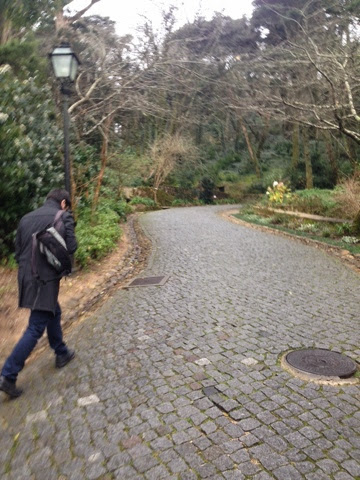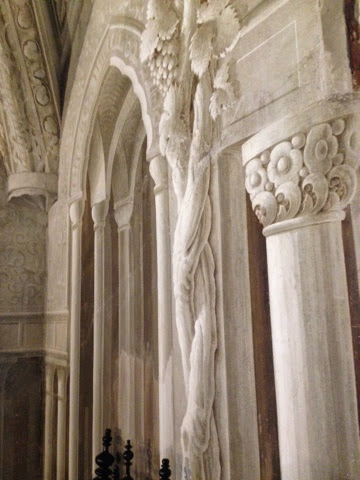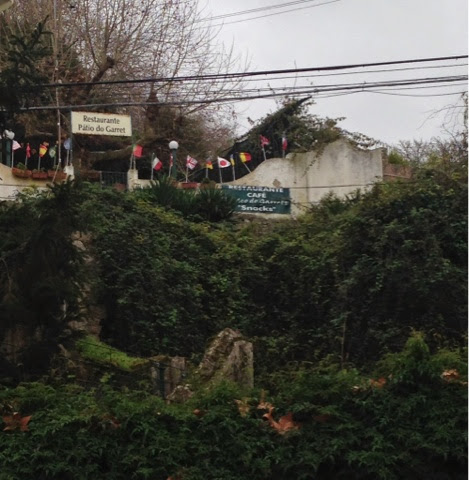Whie we were out we stopped at the little local bakery to have a cup of coffee and a pasteis de nata.I had read they were as good as the pasteis de belem. Nope! They were good but did not even come close. No place to sit you jut stand around at the counter and enjoy your treats.
Since we had gone to the supermaqrket we finally had some food in the house so we could cook in.
Thursday we were heading to Sintra on a tour.
We got up and got going as we had to be at the meeting place for the tour,the Hard Rock Cafe, by 9:00. There were a number of people already there and I looked at Sharon as a number of them were not speaking English. I was scared I had booked us on a Portuguese tour. Then I heard a few people speaking Engish. As it turned out there were two groups meeting there and they divided us up by language. We ended up being a group of 5. One from Costa Rica, who spoke Portuguese, English, and Spanish. She was on a 30 day trip of Europe all on her own. She wa born in Brazil, lived in Mexico City and now works in Costa Rica for the government as an IT Engineer. There was a young nurse from Japan and a young man from Afghanistan currently living in Japan getting his PHD in engineering. It was a very nice group and we shared a lovey day with them. It was also wonderful having someone who could read a Portuguese menu and signage.
The morning was very overcast and rain was predicted so we brought our trusty raincoats in preparation for inclimate weather.
Sintra is small. The town itself sprawls at the foot of a hill. The National Palace, with its unmistakable pair of cone-shaped chimneys , is in the center of town. The whole "Cultural Landscape" of Sintra is designated a World Heritage Site.
Our first stop was a the Pena Palace ( the Feather Palace). The palace sits high above Sintra. " In the 19th century Portugal had a very romantic prince, German -born Prince Ferdinand. A contempory and cousin of Bavaria's "Mad King Ludwig" ( of Disneyesque Neuschwanstein Castle fame). He hired a German architect to build a fantasy castle, mixing elements of German and Portuguese style. He ended up with a crazy Neo-fortified casserole of Gothic towers, Renaissance domes, Moorish playfulness, and an azulejo ( tile)toilet for his wife."
We were a few minutes early so we waited outside until the gates opened.
Finally the gates opened and we began our ten minute walk up to the palace - I emphasize the word up.
 This is the Queen's garden. It was formerly a vegetable garden and 16th century orchard of the Monastery and was transformed into a garden by Queen Dona Amelia,
This is the Queen's garden. It was formerly a vegetable garden and 16th century orchard of the Monastery and was transformed into a garden by Queen Dona Amelia,John explained that the only thing on this hill when Ferdinand came was rocks and grass. He brought in 1000 different types of trees and plants. Pena park is surrounded by 200 hectare or almost 500 acres of tree lined woods and walks. The weather in this area is apparentlly always a little "ify". Very foggy and rainy and cool. It was very clear when we arrived so we could see the gardens and paths very clearly. John said that you don't want to be lost in the woods when its foggy because it is a maze of paths and there is no way you would not get lost. The royalty liked the cooler weather and so this was built to escape the city in the summer.
Ah! Two paths - a requirement for a romantic garden. Which way shall we go? We went to the right.
There are little green buses to drive to the palace if you like but of course we'd rather suffer the walk.
This is a palace, not a castle. It was never built for anything but to live in. There is a drawbridge but it would certainly not keep any enemy at bay.
The palace built in the mid - to late 1800's, is so well-preserved that it feels as if its the day after the royal family fled Portugal in 1910(during a popular revolt that eventually made way for todays modern republic).
At the base of the stairs is a statue of King Ferdinand, who built the castle from 1840-1885, when he died. Though German he was a romantic proponent of his adopted culture and did much to preserve Portugal's architectual and artistic heritage. Throughout the palace are state-of-the-art conveniences
( the first flush toilets and hot shower in Portugal). The king even had a telephone which allowed him to listen to the opera when the commute was too much.
From here you walked out on a patio area where a small cafe is located.
Views of the castle from the terrace. You can see the Atlantic from some areas of the castle. The views are quite spectacular. Unfortunately the clouds came in while we were there and we ended up having a ittle rain and wind.
 Time to stop for coffee and warm up, wait for the rest of the group, and rest our legs for the hike downhill.
Time to stop for coffee and warm up, wait for the rest of the group, and rest our legs for the hike downhill. John came by so got a picture of all the girls. I was going to use my selfie stick but didn't have to. Now, down the hill. Fortunately it wasn't raining.
John came by so got a picture of all the girls. I was going to use my selfie stick but didn't have to. Now, down the hill. Fortunately it wasn't raining.John took us to downtown Sintra and left us off for an hour and a half. We decided to stay together so we headed up the pedestrian street and looked for a place to grab a bit to eat.
Sintra and its mystic hills dotted with fairytale palaces and extravagant villas have bewitched visitors for centuries. The Romans made it a place of cult moon worshiping and named it "Cynthia" after the goddess of the moon. They were followed by the moors who also fell in love with the lush vegetation and built a hilltop castle. Later it became the summer residence of the Portuguese royal family and attracted a number of wealthy aristocrats who built huge mansions and villas.
The famous Bristish poet and traveler Lord Byron stopped by in the 18th century, writing that the town is "Perhaps in every respect the most delightful in Europe".
 These looked good but someone I know doesn't eat fish or liver. Bean stew Portuguese style , maybe. We did find a nice little place and which offered an assortment of light bites for lunch. Bryce could interpet the menu so we didn't get any surprises when the food came. We also all had a dessert that is made in this area , queijadas, which was delicious. Right up there with pasteis de belem. We didn't get to taste their other well known dessert but I'm hopiing that somewhere we will run across them again. They are called travesseiros.
These looked good but someone I know doesn't eat fish or liver. Bean stew Portuguese style , maybe. We did find a nice little place and which offered an assortment of light bites for lunch. Bryce could interpet the menu so we didn't get any surprises when the food came. We also all had a dessert that is made in this area , queijadas, which was delicious. Right up there with pasteis de belem. We didn't get to taste their other well known dessert but I'm hopiing that somewhere we will run across them again. They are called travesseiros.  In the middle of the main square in Sintra is the National Palace, dating from the 14th century. Its two gigantic conical chimney's are the town's most recognizable landmarks, while the rest of the building is a combination of the Moorish, Gothic, and Maneuiline styles. Unfortunately we did not get to the National Palace but the cones are the symbol of Sintra.
In the middle of the main square in Sintra is the National Palace, dating from the 14th century. Its two gigantic conical chimney's are the town's most recognizable landmarks, while the rest of the building is a combination of the Moorish, Gothic, and Maneuiline styles. Unfortunately we did not get to the National Palace but the cones are the symbol of Sintra. I discovered that two in our group had not tasted ginjinha so I felt an obligation to introduce them to it. They were more than willing! This time we had the drink served in a chocolate cup. Very nice. We were also treated to a vanilla tasting liquor. After it was poured ur server squeezed just a couple of drops of fresh lemon in it. Very refreshing!
I discovered that two in our group had not tasted ginjinha so I felt an obligation to introduce them to it. They were more than willing! This time we had the drink served in a chocolate cup. Very nice. We were also treated to a vanilla tasting liquor. After it was poured ur server squeezed just a couple of drops of fresh lemon in it. Very refreshing!As we were driving from Sintra to Cabo da Roca we drove by some cork trees. John filled us in on a few interesting facts about the trees. Only the bark is used from the trees and this is stripped off the trees which helps the tree to grow. Quite unlike most trees which when stripped of their bark,die. The bark takes about 7 years to grow back so each tree that is stripped is marked with the year the bark was removed, We have noticed that you can buy cork jewelry, purses, shoes, slacks, hats. boots, jackets, and whole lot more.
Cabo da Roca is the western most point of the European continent. On the road going in your attention is drawn by the Lighthouse, which is 540 feet high and dates back to 1772. The Cabo da Roca is a significant and inspiring place, and is among the 800 geographical points throughout the world that have been dedicaed to Peace since 1989, through the Sri Chinmoy Peace Blossom program. You can buy a certifcate at the local tourist office for 11 euro's to bear witnss to the fact that you were here. I passed this one up as I fear it would go where my certificate for kaykaying in the Strait of Magellan went - the trash.
This poem by one of the most famous Portuguese poets, Luis de Camoes, was on a sign in the entrance to the Tourist Office.
 Here's John running to the car to get it unlocked and the doors open for us. We were still missing two of our party but we thought we'd wait in the car. John didn't give us a time limit here as the weather was so awful he didn't think any of us would be out there too long. Little did he know. We were just starting to get a ittle concerned when the lat two showed up.
Here's John running to the car to get it unlocked and the doors open for us. We were still missing two of our party but we thought we'd wait in the car. John didn't give us a time limit here as the weather was so awful he didn't think any of us would be out there too long. Little did he know. We were just starting to get a ittle concerned when the lat two showed up. We stopped at this beach so we could take some photographs. This is the only one I was able to get because my phone got wet and wouldn't take any more pictures. This beach is usually very calm we were told. Not today!
 This is called "Hell Hole" which is locatd down the road from the beach. John stopped just long enough for us to get a couple of pictures,
This is called "Hell Hole" which is locatd down the road from the beach. John stopped just long enough for us to get a couple of pictures,Our next stop was Cascais and a drive through Estoril. Before the rise of the Algarve ( in the south of Portugal) these towns were the haunt of the rich and famous. " Today they are quietly elegant, with noble old buildings, beachfront promenades, a bullring, and a casino. "
Cascais has a cozy touch of a fishing village. John was telling us that during the summer its interesting to see the tiny fishing boats in one harbor and right next to it is the harbor full of yachts.
The weather had not improved and so Sharon and I made the decision to find a place and enjoy our hour in town indoors enjoying a cup of coffee and hopefully enjoy one of those desserts we didn't get to sample in Sintra. ((We decided we'd get on a triain and spend a day in Cascais when the weather was better.) Everyone decided to join us. We found a lovely little cafe and they had a fire going downstairs so we gathered around a table and had some coffee and a sample of their desserts. No Travesserios. Hopefully when we get back on a sunny day we will find some somewhere.



















































































































No comments :
Post a Comment